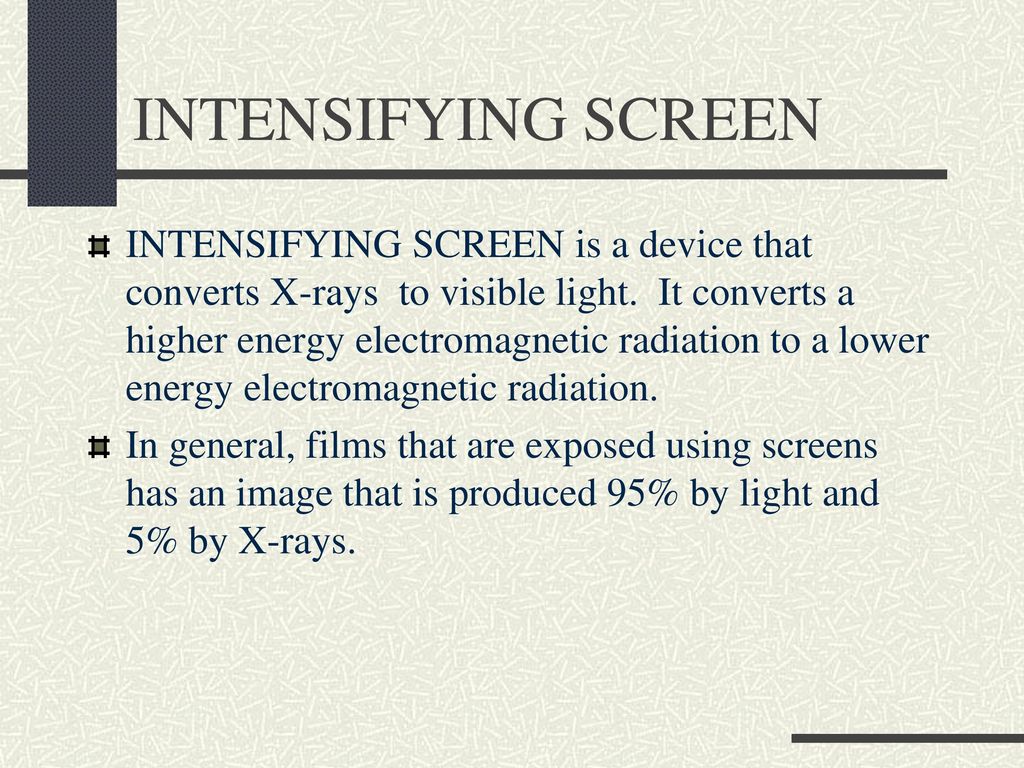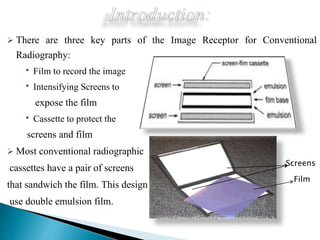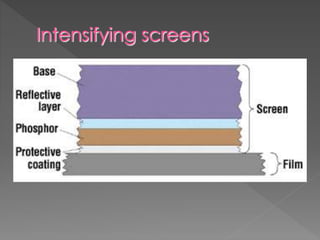Describe the Benefits of Using Intensifying Screens
Intensifying screens are used in the x-ray cassette to intensify the effect of the x-ray photon by producing a larger number of light photons. It decreases the mAs required to produce a particular density and hence decreases the patient dose significantly.
Slow screens require a larger exposure and produce greater detail.

. Measuring the resolving power of intensifying screens without the use of a microphotometer. Thus screens allow much lower mAs settings which decrease loss of detail as a result of motion decrease patient radiation exposure and help prolong the life of the x-ray tube. OVER 99 of the latent film image is due to the intensifying screens light interactions with the film.
Nonscreen cassette image intensifying screen. Phosphors are materials which convert photon energy to light. Dispatchers often use anywhere from two to six monitors to see whats going on in a given area talk to a person in need and communicate with first responders being sent to the scene of an accident emergency or crime-in-progress.
Less than 1 of the x-rays incident on the radiographic film interact with the film contribute to the latent image This permits a great reduction in the amount of radiation necessary to produce a diagnostic quality image. Emit the same color of light that screen x-ray film is sensitive to. The density produced by halation which is correlated to the definition could be measured separately.
Efficiently convert absorbed x-ray energy into visible light. Cassettes serve 3 important functions. The use of intensifying screens has three major benefits o Reduction of patient from MAS 5 at University of British Columbia.
Produce no afterglow types of phosphors 1. They used a perforated plate with small closely placed apertures. It decreases the mAs required to produce a particular density and hence decreases the patient dose significantly.
Dramatically decreases the amount of radiation needed to produce a film of diagnostic radiographic density. What are the Favorable Properties of a Radiographic Intensifying screen phosphor. Protect film from bending and scratching during use.
Have a high level of x-ray absorption capacity. Should emit large amount of light when struck by x-rays. The purpose of intensifying screens is to decrease the radiation dose to the patient.
Benefit is the reduction in dose of ionizing radiation to the patient. The use of intensifying screens in cassettes keeps the exposure time as short as possible but the images are less sharp than those obtained with direct analog film. Start studying intensifying screens.
Should have high atomic so absorption is high. The appearance of phosphorescence that is emission of light inde-. Learn vocabulary terms and more with flashcards games and other study tools.
Introduced Intensifying Screen Advantages of Using Screen - Reduce the dose required for a particular examination resulting in low patient dose - Short exposure time - Low motion unsharpness - Less thermal stress on the x-ray tube - Reduce shielding for x-ray room Disadvantages of Using Screens. The purpose of using intensifying screens in extra-oral radiography is to decrease exposure time. Intensifying Screen x-ray 1.
3 Describe the benefits of using intensifying screens. Hello friends welcome in my youtube channel Radiology technicalfriends radiology technical channel me Drt 1 year or Drt 2 year ke all topics ki study krege. The cassette should be checked regularly for light-tightness to ensure that no light can cause fogging of the film.
The disadvantage of using screens is the reduction in recorded detail. Faster screen speeds require a small exposure and produce less detail. Also Know who invented intensifying screen.
Screens allow lower mAs settings decrease. 0 explanations Explanations are useful to guide through learning process and confirm that the correct answer is indeed correct. Contain intensifying screens keeps film in close contact to screen during exposure.
The primary function of the intensifying screen is to reduce the amount of radiation exposure required to produce a diagnostic radiograph. Advantages of the use of rare earth intensifying screens in the radiologic diagnosis of dysgnathia and maxillofacial dysmorphism. Intensifying screens are used in the x-ray cassette to intensify the effect of the x-ray photon by producing a larger number of light photons.
Weve mentioned them before but it bears repeating. An intensifying screen is a plastic sheet coated with fluorescent material called phosphors. Screens must be cleaned regularly.
Characteristics of Intensifying Screens 1 An intensifying screen consists of a base of polyester or cellulose. Calcium tungstate- emits light in the blue spectrum. Requires less exposure to produce a radiograph because of its sensitivity to the light emitted by intensifying screens.
The CASSETTE is used to hold the film during examinations. Rare earth- emits light in the green spectrum. 1984 Sep52981-2 85 87 passim.
Only registered users can add explanations Facebook. It also reduces motion blur and x-ray tube loading by reducing exposure time. Protect film from exposure to light 2.
Describe the benefits of using intensifying screens Decreases amount of radiation needed to produce film of diagnostic radiographic density. Because screen phosphors can intensify the action of the x-rays by converting them to visible light the use of screens allows the radiographer to use considerably lower mAs.

Intensifying Screen Avinesh Shrestha

Intensifying Screens Ppt Download

Intensifying Screens Ppt Download

Intensifying Screen Performance The Influence Of Sensitivity And Download Scientific Diagram

No comments for "Describe the Benefits of Using Intensifying Screens"
Post a Comment